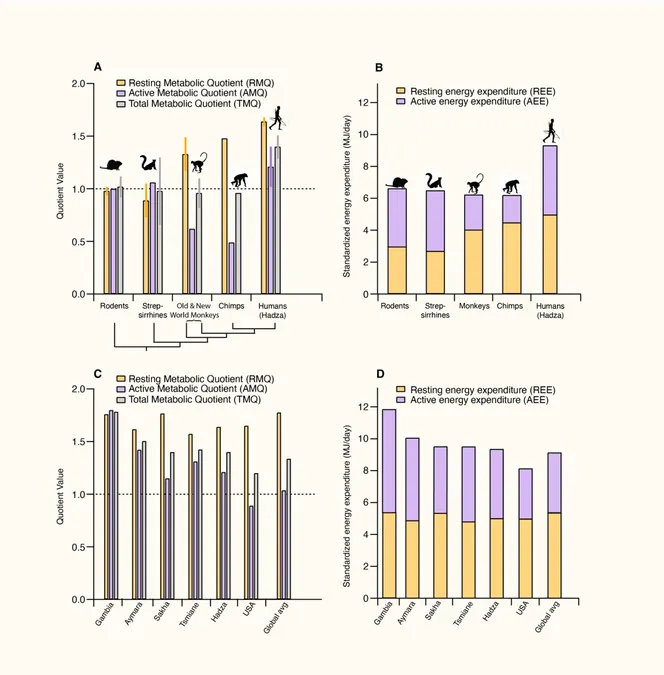
The Astonishing Energy Use of Humans: How We Became Metabolic Powerhouses
2024-11-19
Author: Sophie
Groundbreaking Study Findings
A groundbreaking study from Harvard reveals something astonishing: humans exhibit remarkably higher metabolic rates compared to other mammals, particularly our closest relatives, apes and chimpanzees. This unique trait has been pivotal in shaping our evolutionary path, allowing our hunter-gatherer ancestors to thrive, grow larger brains, live longer lives, and boost reproduction rates.
A Perspective from Researchers
Co-author of the study and paleoanthropologist, Daniel Lieberman, emphasized the significance of these findings, saying, “Humans are off-the-charts different from any creature that we know of so far in terms of how we use energy.” Published in the prestigious Proceedings of the National Academy of Sciences, this research challenges the previous belief that human and non-human primates have similar or lower metabolic rates relative to their body size.
Methodology and Results
The researchers employed a new comparison method that factors in elements like body size, environmental temperature, and body fat, revealing that humans have successfully evaded the tradeoff seen in many other mammals between resting and active metabolic rates. While animals generally expend calories through metabolism, these calories are divided between resting and physical activity, a balancing act that tends to favor resting metabolism in other primates.
Chimpanzees vs Humans
For example, chimpanzees, with their substantial brains and high reproductive costs, fall into the “couch potato” category, as their high resting metabolic needs lead them to spend most of their time foraging for food, minimizing their activity levels. In contrast, humans have evolved not just to boost resting metabolism above that of chimpanzees but also to maintain high physical activity levels—thanks in large part to our unique ability to cool down effectively through sweating. Co-author Andrew Yegian noted, “The result is that we are an energetically unique species.”
The Caloric Investment of Metabolism
According to the study, primates invest approximately 30% to 50% more calories in their resting metabolism than similarly sized mammals. Humans push this to extremes, with a staggering 60% increase in caloric investment. This incredible metabolic efficiency may have played a critical role in our success as a species.
Future Research Directions
The collaborative research team, which includes experts from Louisiana’s Pennington Biomedical Research Center and the University of Kiel in Germany, aims to delve deeper into the metabolic variations among different human populations. Intriguingly, subsistence farmers—who labor to produce their food without mechanization—demonstrate higher physical activity levels than traditional hunter-gatherers or those in industrialized nations.
Implications for Modern Life
However, regardless of lifestyle choices, all human populations exhibit similar energy expenditures for their body size concerning resting metabolic rates. This leads researchers like Yegian to ponder significant questions about modern life: “What we’re really interested in is variation among humans in metabolic rates, especially in today's world of increasing technology and lower levels of physical activity. Since we evolved to be active, how does having a desk job change our metabolism in ways that affect health?”
Conclusion
As we explore the fascinating dynamics of human metabolism, we are forced to confront the implications of a sedentary lifestyle on our health and evolutionary legacy. Stay tuned for more revelations as this research continues to evolve!









 Brasil (PT)
Brasil (PT)
 Canada (EN)
Canada (EN)
 Chile (ES)
Chile (ES)
 España (ES)
España (ES)
 France (FR)
France (FR)
 Hong Kong (EN)
Hong Kong (EN)
 Italia (IT)
Italia (IT)
 日本 (JA)
日本 (JA)
 Magyarország (HU)
Magyarország (HU)
 Norge (NO)
Norge (NO)
 Polska (PL)
Polska (PL)
 Schweiz (DE)
Schweiz (DE)
 Singapore (EN)
Singapore (EN)
 Sverige (SV)
Sverige (SV)
 Suomi (FI)
Suomi (FI)
 Türkiye (TR)
Türkiye (TR)